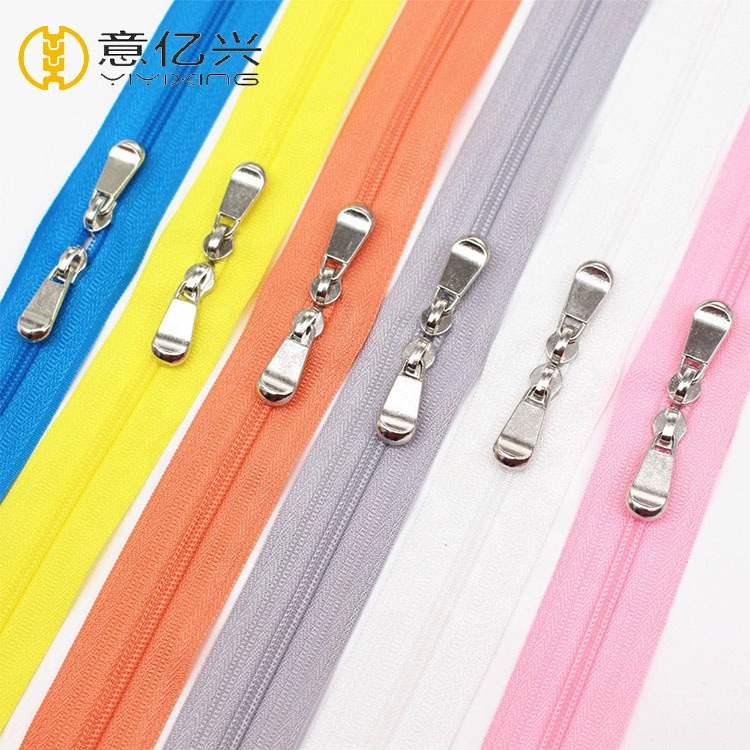Choosing the right zipper is an important consideration when designing or repairing clothing, bags, or other items. A zipper is a fastener that is used to join two pieces of fabric together and is made up of two parallel rows of teeth or coils that interlock when the slider is moved up or down. When choosing a zipper, there are three key things to consider: the type of zipper, the zipper material, and the zipper size. In this article, we will discuss these three factors in more detail to help you choose the right zipper for your needs.
1. Type of Zipper
The type of zipper you choose will depend on the application and the design of the item you are creating or repairing. The most common types of zippers are:
a. Coil Zippers: Coil zippers are made up of a series of nylon or polyester coils that are sewn onto a tape. They are lightweight and flexible, making them suitable for use on curved or flexible items such as bags and clothing.
b. Metal Zippers: Metal zippers are made up of metal teeth that are attached to a tape. They are strong and durable, making them suitable for use on heavy-duty items such as jackets and bags.
c. Plastic Zippers: Plastic zippers are made up of plastic teeth that are attached to a tape. They are lightweight and flexible, making them suitable for use on lightweight items such as dresses and skirts.
d. Invisible Zippers: Invisible zippers are designed to be hidden in a seam, making them suitable for use on items that require a discreet closure such as dresses and skirts.

When choosing the type of zipper, consider the application and the design of the item. For example, if you are repairing a heavy-duty jacket, a metal zipper may be the best option, while if you are making a lightweight dress, a plastic or coil zipper may be more suitable.
2. Zipper Material
The material of the zipper will depend on the type of zipper you choose. The most common materials used for zippers are:
a. Nylon: Nylon zippers are lightweight, durable, and flexible, making them suitable for use on a variety of items. They are also resistant to moisture and abrasion.
b. Polyester: Polyester zippers are strong, durable, and resistant to moisture and chemicals. They are suitable for use on heavy-duty items such as bags and jackets.
c. Metal: Metal zippers are strong and durable, making them suitable for use on heavy-duty items such as jackets and bags. They are available in a range of finishes, including brass, nickel, and antique.
d. Plastic: Plastic zippers are lightweight and flexible, making them suitable for use on lightweight items such as dresses and skirts. They are available in a range of colors and finishes.
When choosing the zipper material, consider the application and the design of the item. For example, if you are making a lightweight dress, a plastic zipper may be the best option, while if you are repairing a heavy-duty jacket, a metal zipper may be more suitable.
3. Zipper Size
The size of the zipper will depend on the application and the design of the item. Zipper size is measured in inches and refers to the width of the zipper tape when it is laid flat. The most common sizes of zippers are:
a. #3: 3mm wide tape, suitable for lightweight items such as dresses and skirts.
b. #5: 5mm wide tape, suitable for medium-weight items such as jackets and bags.
c. #8: 8mm wide tape, suitable for heavy-duty items such as tents and backpacks.
When choosing the zipper size, consider the application and the design of the item. For example, if you are making a lightweight dress, a #3 zipper may be the best option, while if you are repairing a heavy-duty backpack, a #8 zipper may be more suitable.
In conclusion, choosing the right zipper is an important consideration when designing or repairing clothing, bags, or other items. When choosing a zipper, consider the type of zipper, the zipper material, and the zipper size. The type of zipper will depend on the application and the design of the item, while the zipper material will depend on the type of zipper you choose. The zipper size will depend on the weight of the item and the design of the item. By considering these three factors, you can choose the right zipper for your needs and ensure that your item is functional, durable, and stylish.


